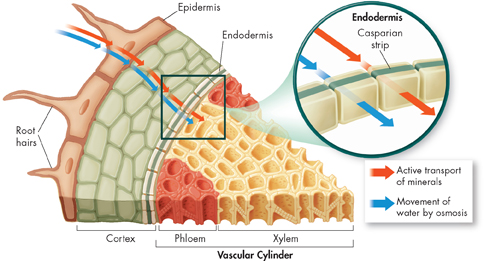Active Transport of Dissolved Nutrients The cell membranes of root hairs and other cells in the root epidermis contain active transport proteins. As you know, active transport is a process that uses the energy of ATP to move ions and other materials across membranes. Active transport brings the mineral ions of dissolved nutrients from the soil into the plant. The high concentration of mineral ions in the plant cells causes water molecules to move into the plant by osmosis.
Water Movement by Osmosis You may recall that osmosis is the movement of water across a membrane toward an area where the concentration of dissolved material is higher. By using active transport to accumulate mineral ions from the soil, cells of the root epidermis create conditions under which osmosis causes water to “follow” those ions and flow into the root. Note that the root does not actually pump water. But by pumping mineral ions into its own cells, the end result is almost the same—the water moves from the epidermis through the cortex into the vascular cylinder, as shown in Figure 23–8.
BUILD Vocabulary
ACADEMIC WORDS The term accumulate means to increase gradually in quantity or number.
Movement Into the Vascular Cylinder Next, the water and dissolved minerals pass the inner boundary of the cortex and move toward the vascular cylinder. The cylinder itself is enclosed by a layer of cortex cells known as the endodermis. The cells of the endodermis are each shaped a bit like a brick. Where these cells meet, their cell walls form a special waterproof zone called a Casparian strip. Most of the time, water can diffuse through cell walls, but not here. The strip is almost like a layer of waterproof cement between the bricks in a wall. Imagine many of these bricks placed edge to edge to build a cylinder, with this waterproof cement surrounding each of the bricks. The only way that water and dissolved nutrients could enter that cylinder would be through the bricks themselves.

FIGURE 23–8 Water Passage Into a Root A root absorbs water and dissolved nutrients from the soil. Interpret Visuals What is the function of the Casparian strip?

Table of Contents
- Formulas and Equations
- Applying Formulas and Equations
- Mean, Median, and Mode
- Estimation
- Using Measurements in Calculations
- Effects of Measurement Errors
- Accuracy
- Precision
- Comparing Accuracy and Precision
- Significant Figures
- Calculating With Significant Figures
- Scientific Notation
- Calculating With Scientific Notation
- Dimensional Analysis
- Applying Dimensional Analysis




